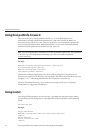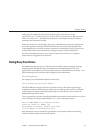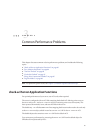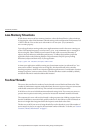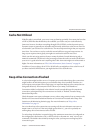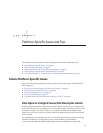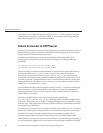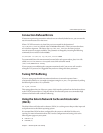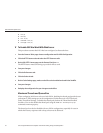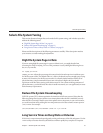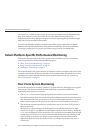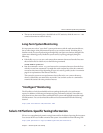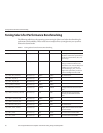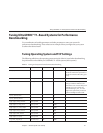
An alternative way to make this change is using the ulimit –n "value" command. Using this
command does not require a system restart. However, this command only changes the login
shell, while editing the etc/system le aects all shells.
Failure to Connect to HTTP Server
If users are experiencing connection timeouts from a browser to Web Server when the server is
heavily loaded, you can increase the size of the HTTP listener backlog queue. To increase this
setting, edit the HTTP listener's listen queue value.
In addition to this setting, you must also increase the limits within the Solaris TCP/IP
networking code. There are two parameters that are changed by executing the following
commands:
/usr/sbin/ndd -set /dev/tcp tcp_conn_req_max_q 8192
/usr/sbin/ndd -set /dev/tcp tcp_conn_req_max_q0 8192
These two settings increase the maximum number of two Solaris listen queues that can ll up
with waiting connections. tcp_conn_req_max_q increases the number of completed
connections waiting to return from an accept() call. tcp_conn_req_max_q0 increases the
maximum number of connections with the handshake incomplete. The default values are 128
and 1024 respectively. To automatically have these ndd commands executed after each system
reboot, place them in a le called /etc/init.d/network-tuning and create a link to that le
named /etc/rc2.d/S99network-tuning.
You can monitor the eect of these changes by using the netstat -s command and looking at
the tcpListenDrop, tcpListenDropQ0, and tcpHalfOpenDrop values. Review them before
adjusting these values. If they are not zero, adjust the value to 2048 initially, and continue to
monitor the netstat output.
The Web Server HTTP listener's listen queue setting and the related Solaris
tcp_conn_req_max_q and tcp_conn_req_max_q0 settings should match the throughput of the
Web Server. These queues act as a "buer" to manage the irregular rate of connections coming
from web users. These queues allow Solaris to accept the connections and hold them until they
are processed by the Web Server.
You don't want to accept more connections than the Web Server is able to process. It is better to
limit the size of these queues and reject further connections than to accept excess connections
and fail to service them. The value of 2048 for these three parameters typically reduces
connection request failures, and improvement has been seen with values as high as 4096.
This adjustment is not expected to have any adverse impact in any web hosting environment, so
you can consider this suggestion even if your system is not showing the symptoms mentioned.
SolarisPlatform-SpecicIssues
SunJavaSystemWebServer7.0Update1 PerformanceTuning,Sizing,and ScalingGuide •90



